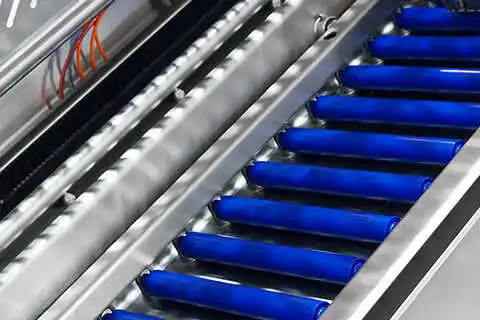Other Conveyor Standards

Conveyor standards address more than just the most popular and widely used types of conveyors. Standards exist for the use of conveyors in niche applications such as fertilizer sampling from a belt, continuous manure scraping, or the sampling of waste streams on conveyors. In addition to establishing standards for the design, manufacture, construction, dimensional characteristics, and operation of a wide range of conveyors, this assortment of conveyor standards showcases the range of both the conveyor industry and standardization efforts.
ANSI/CEMA 102-2012
Conveyor Terms and Definitions
Lists and defines 1,500 terms applying to conveyors, conveyor systems, and allied equipment. Includes over 100 illustrations.
CEMA 705-2004
Conveyor Performance Terminology
A compilation of definitions for terms used in the conveyor industry. It provides a basis of information on characteristics, features, and conditions inherent to practices of material handling through the use of conveying equipment.
ANSI B77.1-2017
Passenger Ropeways - Aerial Tramways, Aerial Lifts, Surface Lifts, Tows and Conveyors - Safety Standard
This document establishes a standard for the design, manufacture, construction, operation, and maintenance of passenger ropeways. For this standard, passenger ropeway categories include: aerial tramways (single and double reversible); aerial lifts (detachable lifts, chair lifts, and similar equipment); surface lifts (T-bar lifts, J-bar lifts, platter lifts, and similar equipment); tows (wire rope and fiber rope tows); conveyors.
ISO/TR 16764:2003
Lifts, escalators and passenger conveyors -- Comparison of worldwide standards on electromagnetic interference/electromagnetic compatibility
ISO/TR 16764:2003 consists of a comparison of electromagnetic interference/electromagnetic compatibility (EMI/EMC) worldwide standards of interest to the lift industry.
ASTM D7204-15
Standard Practice for Sampling Waste Streams on Conveyors
1.1 This practice describes standard procedures for sampling waste on open and closed conveying systems and is applicable to any waste material that can be conveyed to a waste pile or container. The conveyor system can be a vertical (vertical lifts), sloped or horizontal type. 1.2 This practice is intended for particles and slurries, which can be sampled using scoop, dipper, or shovel type samplers. 1.3 The practice is not intended for large size sample constituents, such as boulders, large rocks, and debris. 1.4 This standard does not purport to address all of the safety concerns, if any, associated with its use. It is the responsibility of the user of this standard to establish appropriate safety and health practices and determine the applicability of regulatory limitations prior to use.
ISO 3963:1977
Fertilizers - Sampling from a conveyor by stopping the belt
The method should be used only where other methods, such as automatic sampling of scoop sampling from a free fall, are impossible, or as a reference method.It consists in inserting of two parallel boards or metal sheets vertically down into and at right angles to the streams of the material and to the axis of the stopped belt, and removing of the material between the boards or sheets.
MIL-C-23218C
Conveyor, Vertical, Tray Type, 100 Pound Package Tray Capacity (Shipboard Use)
This specification covers powered, tray type, vertical conveyors used for handling packages up to 100 pounds on board Naval ships.
MIL-C-23842B
Conveyor, Vertical, Tray Type, for 3000 Pound Palletized Loads (Shipboard use)
This specification covers powered tray type vertical conveyors used to move palletized loads up to 3000 pounds aboard Naval ships. Only one classification of conveyors is covered by this specification.
ANSI/CEMA 405-2003 (R2015)
Slat Conveyors
The fifth in a series of standards applying to unit handling conveyors. It establishes recommended engineering and application practice for this type of equipment, offers a uniform nomenclature and certain dimensional standards.
ANSI/CEMA B105.1-2015
Specifications for Welded Steel Conveyor Pulleys with Compression Type Hubs
Provides recommended load ratings, dimensional information, and criteria for selection of welded steel conveyor pulleys. The 2015 Edition includes Metric Conversions.
ISO 2406:1974
Continuous mechanical handling equipment - Mobile and portable conveyors - Constructional specifications
Specifies the dimensional characteristics of mobile and portable conveyors.
ISO 5710:1980
Equipment for internal farm work and husbandry - Continuous manure scraper conveyors for stalls
Specifies requirements for the characteristics, dimensions, methods of installation and safety of closed- circuit conveyors. Applies to evacuation devices fitted with scrapers, moving continuously in a closed circuit, inteded to remove solid and liquid manure collected in non- grid covered channels in enclosed stalls. It applies to elevators only in so far as these from part of the circuit.
ISO 9851:1990
Continuous mechanical handling equipment - Overhead electrical monorail conveyors - Definitions and safety rules
Defines basic terms and specifies safety rules for overhead electrical monorails for materials handling, including the tracks, supporting structure, lifting and lowering devices, the trolleys and the load-supporting devices. Does not apply to systems driven by hand or by gravity, or to systems for conveying people.
ISO 2140:1975
Continuous mechanical handling equipment for loose bulk materials - Apron conveyors
Specifies the main dimensions concerning the construction of apron conveyors, namely pitch of chain, width of apron, height of cheek plates. Practical examples are also given.
ISO 7189:1983
Continuous mechanical handling equipment - Apron conveyors - Design rules
Establishes design rules for apron conveyors used for the transport of both loose bulks materials and unit loads.





